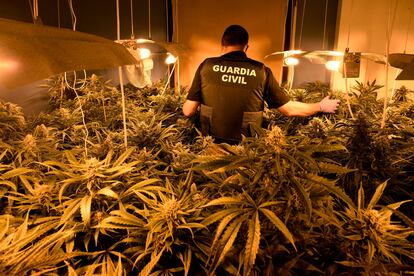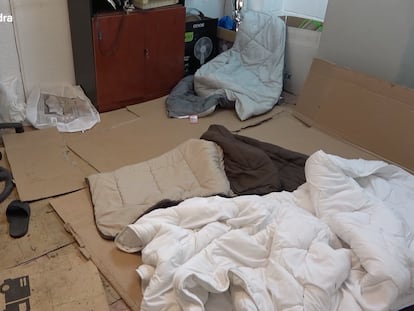Why marijuana plantations are spreading across southern Spain
With seizures jumping eighteenfold in Almería province, authorities warn that growers are passing off illegal cannabis as hemp for industrial use

In 2021, Civil Guard officers seized just over 630,000 marijuana plants in Almería province, in the southern Spanish region of Andalusia. In 2020, this number was just 34,000. In other words, in the space of a year, the figure has multiplied by 18 – a spectacular increase that officers and Spain’s public prosecutor have been warning of for some time. Inside the province’s ubiquitous greenhouses, recreational marijuana is flourishing in the guise of legal hemp crops for industrial and medical purposes, and a multi-million dollar business with it.
Almería has gone from not having a single hectare of declared hemp in 2018 to 230 hectares in 2021, according to data from Spain’s Agriculture Ministry and the Andalusian regional government. The situation is mirrored in other parts of Spain, where plantations have increased eightfold in just five years, now covering 570 hectares. It is mainly being grown in Andalusia, with Almería as the main grower followed by the provinces of Cádiz and Granada. The regions of Valencia, Murcia, Catalonia and Castilla-La Mancha have also seen a rise in marijuana plantations. Just in Toledo, in Castilla-La Mancha, more than 200,000 cannabis plants were seized in October in the municipalities of La Guardia, Sonseca and Huerta de Valdecarábanos.
In a bid to curb the growing hemp frenzy, the Interior Ministry has developed an initiative to tackle marijuana trafficking. Cannabis hauls have quadrupled in five years, with more than three million plants seized in 2021. This is a record for a country that is already the main producer of marijuana in Europe. The latest report from the Attorney General’s Office warned of the numerous attempts to pass off illegal plantations as hemp for industrial use. According to the Agriculture Ministry, Castilla-La Mancha, with 232 hectares, and Andalusia, with 174, had the largest surface area of plantations in 2020, the last year for which data is available. Given how quickly plantations are popping up, however, the current number is expected to be much higher.
According to the public prosecution in Andalusia, the recent increase in marijuana plantations in Almería has been “exponential.” In fact, of the 630,000 plants seized in 2021 by the Civil Guard, more than 400,000 were allegedly hemp. But this is only the tip of the iceberg of what is going on in the province, where 169 people were arrested including a lieutenant from the security forces and 11.6 tons of marijuana ready for sale were seized. The data does not include, for example, cannabis raids by entities such as the Coordination Body against Drug Trafficking (OCON-SUR), whose Operation Imprevisto seized 5.6 tons of marijuana in La Mojonera last summer, or those carried out by the National Police, which confiscated 79,000 plants cultivated indoors last year, with 274 arrests made.
Criminal organizations with indoor plantations are now buying farms and greenhouses to grow what is supposedly industrial hempMaría Ángeles Pérez, narcotics prosecutor in Almería
“Criminal organizations with indoor plantations are now buying farms and greenhouses to grow what is supposedly industrial hemp,” explains María Ángeles Pérez, a narcotics prosecutor in Almería. She has carried out several operations with the Civil Guard, targeting cannabis crops whose producers have come up with explanations bordering on the absurd such as they are part of a “literature review” on cancer. Other growers claim they are in the process of requesting the necessary authorization. There are also those who hand over wads of documents that indicate numerous intermediaries and destinations in northern Europe linked to companies dedicated to anything but hemp.
The price of hemp for industrial purposes is very low, so compared to tomatoes or other traditional greenhouse crops in Almería, there’s little profit to be made, and as such, it has not been traditionally popular with farmers. A kilo of marijuana buds, however, can cost around €400, generating a lucrative business. The Civil Guard points out that, next to the crops, there are usually drying areas that contain buds that the hemp industry does not use, but the black market does. It has also been noted that the growers’ modus operandi involves armed security, the presence of international mafias and transportation in trucks with strong security measures – exactly like any other area of drug trafficking.
At first glance, hemp and marijuana plantations are exactly the same. They grow, in effect, the same plant. It is only the use of cannabis that makes it legal or otherwise. Cannabis is legal when the crop is grown for industrial use – generally fiber – or for the oil extracted from it. It is not legal, according to sources from the public prosecution, to sell the buds, regardless of the amount of THC – the psychoactive component tetrahydrocannabinol – they contain, as indicated in the 1961 Vienna Single Convention. But there is a certain grey area that makes police work difficult as, according to the Agriculture Ministry, it is not considered a narcotic drug if it has less than 0.2% THC. In any case, growing cannabis for medicinal purposes needs authorization from the Spanish Medicines Agency.
This authorization is not required for those growing the plant for industrial purposes, but many growers are unable to adequately prove this is what they are doing. Which is where the security forces come in. In fact, public prosecutors say that the increase in police operations has prompted many farmers to get rid of their plants to avoid problems with the law.
Tu suscripción se está usando en otro dispositivo
¿Quieres añadir otro usuario a tu suscripción?
Si continúas leyendo en este dispositivo, no se podrá leer en el otro.
FlechaTu suscripción se está usando en otro dispositivo y solo puedes acceder a EL PAÍS desde un dispositivo a la vez.
Si quieres compartir tu cuenta, cambia tu suscripción a la modalidad Premium, así podrás añadir otro usuario. Cada uno accederá con su propia cuenta de email, lo que os permitirá personalizar vuestra experiencia en EL PAÍS.
¿Tienes una suscripción de empresa? Accede aquí para contratar más cuentas.
En el caso de no saber quién está usando tu cuenta, te recomendamos cambiar tu contraseña aquí.
Si decides continuar compartiendo tu cuenta, este mensaje se mostrará en tu dispositivo y en el de la otra persona que está usando tu cuenta de forma indefinida, afectando a tu experiencia de lectura. Puedes consultar aquí los términos y condiciones de la suscripción digital.










































